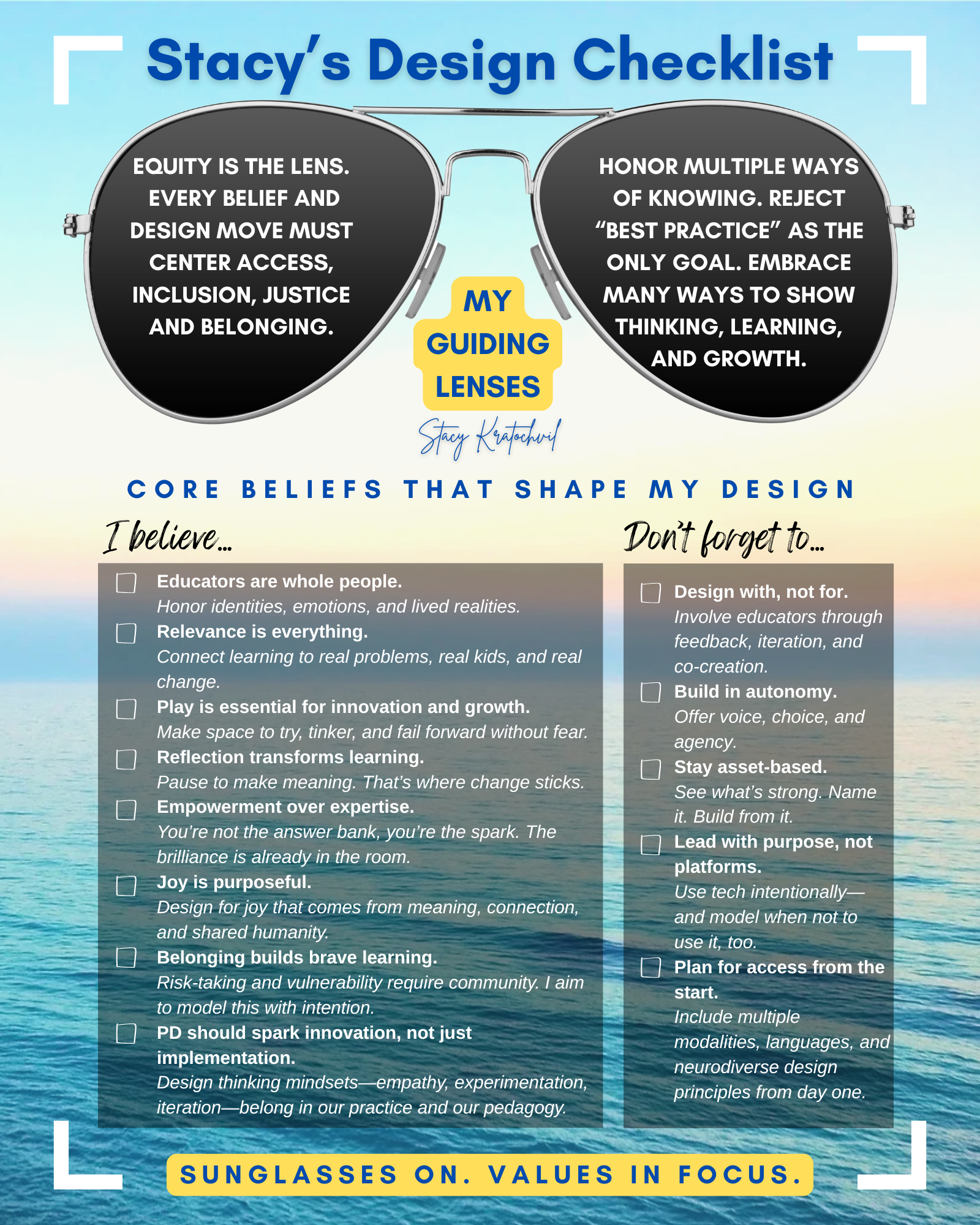April 29, 2025
How to use AI to stay super aligned to your values
Values are like fingerprints. Nobody’s are the same, but you leave them all over everything you do.”
— Elvis Presley
So here’s a question for ya: What kind of fingerprints are you leaving behind in your classroom, your meetings, your plans?
Because whether we realize it or not, our values show up in everything we do. They shape our choices, our tone, and our relationships. And if we’re not careful, they can get lost in the noise.
That’s where AI has surprised me.
Instead of pulling me away from what matters, it’s actually helped me get closer to it. I’ve used AI to help me name what I care about most. To reflect deeply and even feel more confident, more focused, more… me.
Why Values Alignment Matters (Especially in Education)
When you’re ridiculously aligned to your values, you stop chasing trends and start creating meaningful, lasting change. Instead of just “delivering PD” or “writing lesson plans,” you’re building something that feels like you.
Something rooted in purpose.
Something people can feel.
And when things get messy (because they always do), your values are what bring you back to center.
They become your compass.
How I Used AI to Define My Core Beliefs
Late at night, after my kids went to bed (when my brain gets to make some space for deeper thinking) I sat down with ChatGPT. We talked about what I care about most as a learner, teacher, and leader. I started putting those ideas into words, shaping them into “I believe…” statements that reflect who I really am in my work. That quiet, reflective process helped me name what matters. Since then I’ve used those beliefs as a guide while brainstorming, iterating, drafting plans, etc. They’ve helped me stay grounded, make better decisions, and feel more aligned than ever. My work feels fulfilling. I lead and design with a clear purpose. That feels unstoppable.
Here’s the 4-step process I used. Go give it a whirl, too!
1. Reflect on your values and experiences as a learner
Answer a few short questions about your teaching experience. You can jot notes, use speech-to-text, or just think through them:
- When have you felt most energized or fulfilled while teaching? What about as a learner?
- When have your students been deeply engaged? What made that possible?
- What do you believe every learner deserves in a learning space?
- How do you create a sense of safety, belonging, or inclusion?
- What drives your decisions as an educator? What values show up again and again?
- What lasting impact do you want your students to carry with them?
2. Turn those values into belief statements
Open your favorite AI chatbot and paste the following:
“I just reflected on some key moments from my teaching and learning experiences. I’d like to turn my values into a short list of core beliefs about learning.
Here are my responses:
[Paste in your answers]
Can you help me identify themes or patterns and turn my values into 5–10 belief statements that reflect my philosophy as an educator? Please start each with “I believe…” and keep the tone reflective, authentic, and student-centered.”
3. Revise and make it yours
Use the AI-generated draft as a starting point. Ask follow-ups like:
- Can you simplify this into a shorter list?
- Can you make this sound more like my voice? Make it more [warm/direct/joyful/etc]?
- What’s missing based on what I wrote?
4. Use it like a checklist
Now for the BEST PART! Use this list to guide unit, PD planning, or even your parenting. (Let’s be real, this is not just for your professional life!) Include these in your portfolio, slide decks, coaching conversations or even personal branding. Revisit and update them annually as part of your professional reflection.
While turning your checklist or guiding document into a visual graphic like the one below is completely unnecessary and a bit extra, I find it handy to have a pretty reminder. A Google Doc works, too. Or even just a list you copy and paste from your AI chat straight into a custom GPT… But I find that my making mine public it’s another way to mentally hold myself accountable!

*The sunglasses are part of the visual metaphor. I always have sunglasses. And whenever I think about the “lenses” through which I see education, I picture myself putting on my Ray-Bans. So I knew while reflecting on my beliefs, I just had to tie that in somehow. What’s your teaching lens? What anchors your perspective?
3 ways to use AI to stick to your core beliefs
- Start a new chat, upload a PDF or copy/paste your core beliefs and ask to not only reference them, but help you stay aligned to your values and beliefs about learning while designing learning experiences (for kids or adults) or making decisions.
- Create a custom GPT with your core beliefs in the knowledge base.
- Create a visual of your core beliefs to use as a checklist that serves as a reminder or final checklist while planning. I have it printed and framed on my desk!
AI helps me be more me.
More aligned. More intentional. More human.
AI didn’t replace any of my ideas. It helped me see them. It gave me space to reflect and a structure to name what I believe.
This is a super win for personal fulfillment…
We need more educators designing from a place of deep purpose and more spaces (with both humans and tech) that help us reflect and grow!
Because when we lead with what we believe, we create classrooms that feel more like us. Places of trust, purpose, and connection. Places where students feel seen, safe, and inspired to bring their full selves too.
Want to Try It?
Share this blog or the shareable PDF with the steps. Then, grab your favorite chatbot to reflect, collaborate, wordsmith, and have an iterative and deep conversation with.
Share your beliefs with the world and tag us on social media!
- Want to dive deeper? Check out our AI Capstone Program.
- Learn more about our Silicon Valley Artificial Intelligence Project.
Note on AI Use:
I used ChatGPT to help me organize and refine my thoughts for this blog. I provided the ideas, notes, and direction, and the AI tool helped me pull it all together. I reviewed and edited everything to make sure it reflects my voice, stories, emojis ?, and the message I want to share.

